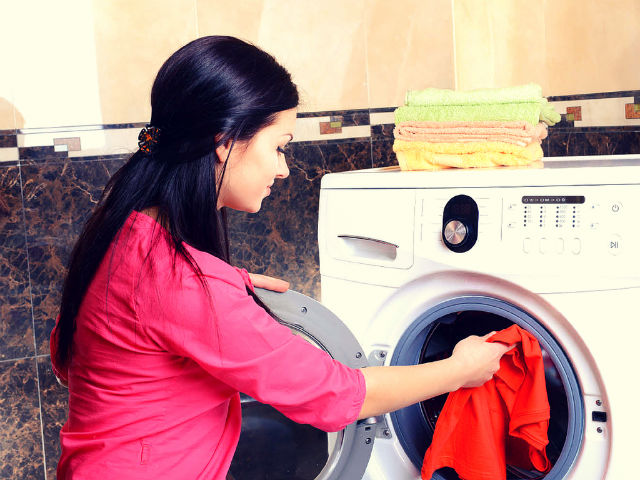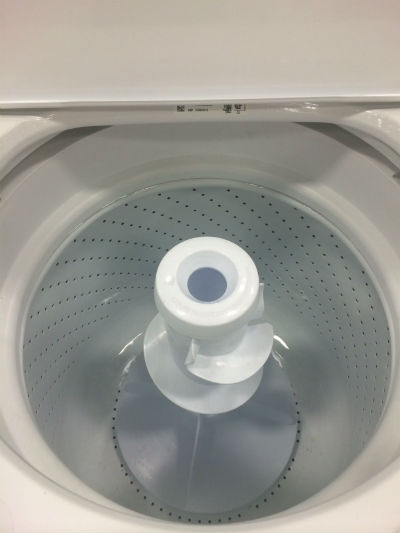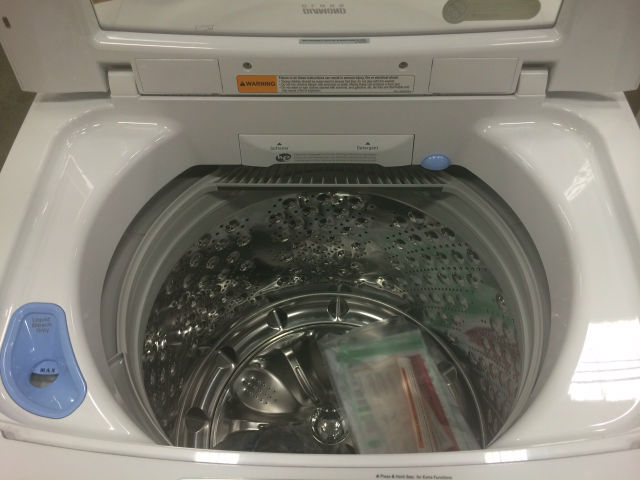
When you think about controversial life choices, selecting a washing machine probably isn’t high on that list. However, a quick troll through the comments section of numerous consumer websites reveals a deep division between front-loading fanatics and top-loading lovers.
The bones of contention are numerous and varied, and many simply boil down to personal preference. But there’s no doubt that the introduction of high efficiency front-loading washing machines into the consumer space has transformed a once straightforward buying decision.
For us eco-warriors, however, the choice has seemed simple: the HE front loader is the sustainable choice. Almost all front loading washing machines on the market are high efficiency Energy Star® rated models, meaning they use about 35 percent less energy and 35 percent less water than regular washers. They also have a greater tub capacity, so you can run fewer loads to clean the same amount of laundry. If you cared about the environment, the notorious water hog known as a top loader was just not an option — until now.
Over the last year, leading manufacturers have introduced high efficiency top loading models. They look like the traditional top loader in your grandma’s house, but inside they work in the same way as a front loader: not wasting water by filling up the tub nor destroying clothes with an aggressive agitator. Instead they use wash systems that flip or spin clothes through a stream of water, combined with sensors that monitor incoming water levels and temperature. They also rinse clothes with repeated high-pressure spraying instead of soaking them in a full tub of water. Plus, no agitator means more room for clothes, and newer top loaders boast some of the highest capacities currently available.
This is good news for top loading lovers. You can still have your sustainability cake and eat it, too. Here’s a rundown of the pros and cons of purchasing a HE front loading washing machine compared to a top loading model:

Cleaning Capability
HE front loading washers are generally thought to clean better than even the best HE top load models. Many also come with a steam setting, which cleans tough stains better and quickly refreshes fabrics. HE front loaders do take longer to complete a normal cycle than a traditional top loader, because the clothes don’t sit in the water; instead, they cycle in and out of the water. HE top loaders also operate this way, but both make up for this increased washing time by spinning much faster than traditional top loaders — up to 1400 rpm compared to 650 rpm — resulting in shorter drying times.
Winner: HE Front Loaders
Wear and Tear on Clothing
Traditional top loaders have agitators to move the clothes around, but this is very hard on clothing. A huge advantage of front loaders when they first arrived on the market was the lack of an agitator; instead, they use gravity to move clothes around. The redesigned top loaders have eliminated this feature, replacing it with a wash plate — essentially a much smaller agitator that doesn’t impact clothing in the same way. You do need to make sure you place the clothes around the wash plate, however, and not just pile them on top of it.
Winner: Any HE machine will be gentler on clothing than traditional top loading models.


Load Size
Higher capacity washers wash more clothes in one go, meaning less energy and water use. Front loaders used to have the upper hand over top loaders for capacity, boasting up to 4.5 cu ft., but thanks to the removal of the agitator in higher end top loaders, the largest capacity machine is now a HE top loader. Samsung’s WA9000 boasts 5.6 cu. ft. capacity and claims to turn laundry day into laundry hour.
Winner: A HE top loader currently offers the largest capacity.

Space Saving
If you’re short on square footage, or looking to downsize to lessen your habitat’s impact on the environment, then front-loading machines are the best option because many are stackable. Additionally, the front loader offers the convenience of a work surface for folding clothing.
Winner: HE front loader.
Water Heating
Front loading washers improve efficiency by heating the water in the machine, not drawing from your home’s hot water tank. This is one factor that contributes to longer wash times for front loaders. Top loading washers traditionally draw on hot water from your home’s supply; less efficient, but faster. With newer top loaders, water heating varies by model, so check to make sure the one you are considering heats its own water.
Winner: Any HE machine.
Less Detergent
All HE washers require the use of HE detergent, which is highly concentrated, requiring only two tablespoons per load. This results in a huge saving on packaging.
Winner: Any HE machine.
Price
Common wisdom dictates that HE front loaders are twice as expensive as top loaders, but they should offset their cost through increased energy savings. This is still true when compared to traditional top loaders, but when it comes to HE top loaders, things are pretty much even. Today you can pick up a front loader for between $600 and $1200 and an HE top loader for between $600 and $1400. Traditional top loading machines start around $400.
Life Expectancy
The average life expectancy of a washing machine is between 11 and 14 years: 11 for a front loader and 14 for the traditional top loader. However, there is substantial customer feedback indicating HE front loaders experience higher mechanical failures compared to old-fashioned top loaders, leading to some manufacturers claiming an LE of closer to seven years for HE models. This is a trend increasingly seen in modern appliances as a whole; the more bells and whistles on machines, the more potential for failures. Avoiding touch screens and other more advanced features, at least for the first year or so of manufacture, is probably wise. Alternatively, opt for models that have extended warranties on these features.
As top loading HE machines are very recent, there is not much data available on potential mechanical issues. However, this is the one area where, anecdotally, traditional top loaders may have an edge. Some people report their machines running happily for over two decades. But the high energy and water use of these machines likely cancels out any sustainability benefits of the longevity.
A very big concern with any HE washer is mold. There are currently numerous class action lawsuits being pursued against some manufacturers because consumers discovered brand new machines developing mold problems.

The main culprit is humidity that stays in the washer. Excess soap (from not using HE detergent) and grime can also keep some areas damp. Because of the low water level, wash residue, softeners and detergents don’t always fully drain from a front loader. Using cold water for most loads can also exacerbate the problem.
Thankfully, manufacturers have addressed this issue, making design changes that experts say have eliminated the mold issue. These include incorporating self-clean cycles, that should be run at least once a month, adding magnetic door ventilation features to keep the washer door open and allow air to circulate between loads, and introducing antimicrobial door gaskets with drain holes to help the gasket dry more quickly. Look for models with these added features, and avoid any secondhand models manufactured before 2009.
Conclusion
Top loading washers are clearly catching up with their front loading counterparts in the HE stakes, and if your personal preference has always been up top, but you felt compelled to go in front for the good of the planet, you’ll be pleased to know you now have options. Follow this quick checklist when buying your HE top loading or front loading washing machine to make sure you get the best green for your buck:
- Energy Star and CEE Tier III rated
- Delay Start Option (to run the machine during off peak hours)
- Internal Water Heater
- Large Capacity 4.3–5.6 cu. ft.
- High Spin Speed, 1000 rpm or higher
- Stainless Steel Drum
- Self-Clean Cycle
- Cold Wash Option
- Quick Wash Option
- Automatic Water Level Adjustment
- No Central Agitator
Jennifer Tuohy writes about green technologies and energy-efficient appliances, including washers, for Home Depot. A selection of front-load and top-load washing machines available at Home Depot, including styles Jennifer discusses, can be found on the company’s website.

Shweta Joves
Sometimes its really fuss to select the different loads in Washing Machine. But this blog isreally helpful, m also thinking to by one washing machine, now lets see.
Breaux Jeff
Top loader machines save water in comparison to frond loader washing machines, and I think they have long life. Sometime back I bought a washing machine from PC Richard & Son which is a front loader machine and after some time it stopped working and when I called them to repair they did not give any answer to my calls. That was the worst buying experience. Now I am thinking of buying a new washing machine and your blog is really very helpful in making a choice.
nnaemeka ulasi
Wish o read this before buying my top loader. Guess I’ll factor this in on my next purchase
Krishna Services Pune...
Nice information , You are blog is very good.
Thanks for sharing this blog.
Washing Machine on Rent in Pune
renukaanama
washing machine Service Center secunderabad feel free to contact customer service for further assistance
040-60506611, 040-60506622 Click here
Karen Azatyan
https://longbeachappliancerepairs.com/top-loading-washing-machines/
Sreedhar Reddy
Your blog is providing lot of information thanks
http://www.wschyderabad.com/washing-machine-service-center-in-hyderabad/
Kuldeep Sharma
Very good blog. Very useful for people who are into washing machine service. Please keep writing more. Thanks. http://sornavalliconsupport.in/